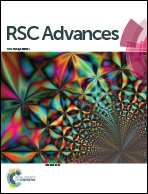Simple, rapid, sensitive, selective and label-free lincomycin detection by using HAuCl4 and NaOH†
Abstract
A simple, rapid, sensitive, selective and label-free method is presented for the colorimetric determination of lincomycin (Lin) by using HAuCl4 and NaOH. Upon the addition of Lin, the mixture of HAuCl4 and NaOH shows a color change from colorless to blue (or dark blue). The limit of colorimetric detection is as low as 1 μM, observed both in Milli-Q water and real samples. The selectivity of Lin detection is excellent compared with 9 other common antibiotics. On the basis of the “three-color” principle of Thomas Young, we extracted the red, green and blue (RGB) alterations of the sensor in the absence and presence of different concentrations of Lin. The color changes are quantitatively illustrated by the total Euclidean distances (EDs = [ΔR2 + ΔG2 + ΔB2]1/2). The good linear relationship between the EDs and Lin concentration is used for the quantitative assay of Lin. The developed method demonstrates great potential for the detection of Lin in environmental water and milk.



 Please wait while we load your content...
Please wait while we load your content...